This week, a eulogy. Some words of remembrance, even adulation to an old and dear friend, a friend who faithfully remained at my right hand side for many years. A friend who felt my frustrations in learning to drive, the first to feel my thrill of finally winning control over an automotive contraption, the one who never failed to tell me that 2 comes after 1, not 3, not 4, nor the letter “R.” I speak of course of my dearly beloved companion — the stick shift.
Born to Emile Levassor and Louis-Rene Panhard in 1894, the manual transmission and its essential component, the stick shift, started out life as a simple chain drive — essentially a bicycle chain assembly attached to a clump of sprockets called a change speed gear box and was shifted up and down with a pedal called a clutch.
These first Panhard-Levassar two cylinder babies delivered an astounding four horsepower and could do 19 km/h. ‘Système Panhard’ was the gear shifting standard until front-wheel drive cars started gaining popularity in the 1960s, but is still found in lots of larger, albeit older model cars, today.
Since 1894, the changes to that box of gears at the end of your stick shift have been revolutionary. “Synchro,” “hydramatic,” “automatic” and “torque converter” are some of the names synonymous with these leaps of automotive technology. They made our cars not only faster, but more efficient and reliable, with no third pedal.
Most cars today zip along via a contraption with the unalluring title of: “continuously variable transmission” or CVT — a system of pulleys and flexible belts as opposed to traditional gears.
I didn’t learn to drive on a stick, but back when dinosaurs still ruled the earth, the economics of driving while you’re still in school and working meant driving a cheaper, more efficient car. The manual transmission was the answer.
The learning curve was definitely steeper but that manual stick shift put you in control.
I decided when to gear up or gear down. I decided how far to rev the tachometer on that 1600cc 1972 Datsun 510 — nobody else! Well except maybe when my dad was in the passenger seat.
Those feelings of simplicity and control were actually quite intoxicating. The manual world of the stick shift, also meant paying greater attention to your driving. It couldn’t always be about sucking up the last few drops of that grape slurpee as your light changed to green. You had to make sure you were in gear, ready to go, clutch in, slow release, 1st gear, then smoothly up into 2nd, 3rd etc.
Once the process was understood and that friction point, where the clutch kicks in, was mastered, driving became a cinch. Like most 18 year olds — I now knew everything.
Unfortunately, technology started wrecking the party. By 2012, engineers were putting more gears into automatics than in standard transmissions. The ability for the car to effortlessly shift up to higher and higher gears made for smoother, less resistant mechanics, leading to dramatic increases in fuel efficiency.
Those who still demanded the fun and control of manual shifting found little impact against the corporate will of the auto giants, now prioritizing greater demand for better mileage.
By 2020 only 1.3% of vehicles sold in the U.S. had standard transmissions. Even the vaunted Chevy Corvette, the epitome of hard shifting and cool driving, no longer offers a manual transmission.
Recently, auto engineers have offered up some faux substitutes for the stick shift of old, but it’s not the same.
Paddle shifters, which as the name implies, are paddle like controls on either side of a steering wheel, allowing a driver to change gears by just flicking them with your fingers. But it’s not good old fashioned gear changing. The paddle simply tells your car’s computer that you want to use a lower or higher gear.
With the era of the electric car already on us, will the manual transmission be reborn? Unlikely, according to most pundits. But the industry is aware that there is still a small market for people who need that stick shift and third pedal experience and are willing to pay for it.
Some aftermarket firms now offer an electric motor conversion kit for those who want to keep the family flivver, with the stick shift, forever. But it is a costly and inefficient conversion.
There are currently only two “from the factory” electric cars on the market offering a “sort-of” manual transmission: the Porsche Taycan Turbo S Cross or the Audi e-Tron GT — frugally priced at $187,600 (US) and $101,00 (US) respectively. I’m not that keen to be an early adopter.
For now I’ll simply keep faith that tech will one day resurrect my old dear friend at a price I can afford.



